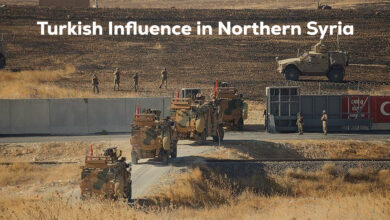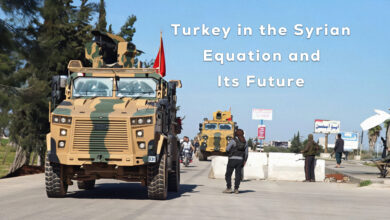
Since the outbreak of the Syrian crisis in March 2011, Turkey and Iran have sought to carry out their expansionist plans in Syria; Turkey found in the demonstrations erupted in Syria an opportunity to realize its neo-Ottoman ambitions and dreams, so its interests converged with the Muslim Brotherhood in Syria, that sought to overthrow the Syrian regime and control the country. Supported by Qatar, the Muslim Brotherhood became a pliable tool in the hands of Turkey to achieve its goals at the expense of the defenseless Syrian people. While Iran involved in the incidents through its militias to achieve the so-called Shiite Crescent through Iraq to shiitize the region and drain its resources and energies. Both the Turkish and Iranian regimes differ in doctrine but their goal is the same which is to occupy the region, usurp the rights of its communities and play on racist and sectarian tendencies.
In order to achieve this, Turkey has employed Sunni factions in Syria the matter led to the creation of a sectarian dimension that led to a civil war which resulted in the appearance of extremist organizations such as ISIS and al-Nusra Front. On the other hand, Iran has used Shiite militias like Lebanese Hezbollah and Quds Brigade aiming at eliminating the aspirations of the Syrian people in changing the regime and targeting the Kurds. Thus, the conflict turned from overthrowing regime to a sectarian war with Turkish and Iranian support through using their proxies on the ground.
The Syrian conflict led to mass waves of displacement which have been taking place systematically and carefully between Turkey and Iran in order to create a demographic change in line with their interests by striking the Syrian diverse communities and races. The most prominent example of that is the attack launched on the two Kurdish-majority neighborhoods of Sheikh Maqsoud and Ashrafiyah in the city of Aleppo in 2013 by armed groups (mercenaries) allied with Turkey. The attack was coincided with bombing by the Syrian regime which resulted in the displacement of more than 300.000 people from the two neighborhoods. In summer of 2013, the attacks launched by al-Nusra Front and other armed groups allied with Turkey on the two Kurdish villages of Tel Hassel and Tel Aran, southeast of Aleppo, led to the displacement of tens of thousands of the residents. In conjunction with these attacks, forces of the Syrian regime and Iranian-backed militias were committing human rights violations against predominantly Sunni Arab areas in northern Syria. This was done through displacing the original people of areas in northern Syria via green buses to Idlib Governorate.
In 2013-2014, the cities and towns of Rastan, Baba Omar, al-Waer, al-Qusair, Tel Kalakh and others in Homs Governorate were evacuated to become empty areas separating the Sunni and Shiite groups. After that, areas in Rif Dimashq Governorate were evacuated through sending militants of the opposition groups with their families to Idlib and the regime’s control of Rif Dimashq in exchange for allowing Turkey to control Jarablus region in Aleppo countryside.
At the time, Turkey was employing ISIS to attack the Kurdish areas and bring militants to work for it as mercenaries. In late 2014, ISIS, with Turkish support, attacked the city of Kobani which led to the displacement of more than half million Kurds from their homes. On the other hand, Iran adopted a similar approach in Deir ez-Zor and other areas aiming at achieving a systematic demographic change. A large part of the original people of the abovementioned areas are still in IDP camps which lack the minimum necessities of life before the eyes of international and human rights organizations without moving a finger.
2018 witnessed the largest displacement process and demographic change where Turkish forces and their mercenaries attacked the Kurdish city of Afrin and occupied it, forcibly displacing about 300.000 to an area in the northern countryside of Aleppo, known as Shahba Region which is run by the Autonomous Administration. The Turkish attack on Afrin and the displacement of its original people took place in the form of a deal sponsored by Russia according to which Eastern Ghouta in Rif Dimashq was handed over to the Syrian regime, bringing the opposition militants and their families to Afrin and settling them in the homes and lands of Afrin IDPs to be added to settlers from other areas gathered by Ankara in Afrin to bring about demographic change in this Kurdish region. Such bartering processes continued to include the two Shiite towns of Fu’ah and Kafriya, in Idlib Governorate, in exchange for Zabadani and Madaya, in Rif Dimashq, and Sere Kaniye (Ras al-Ain) and Tel Abyad, in northern Syria, in exchange for areas of Idlib and Hama.
From time to time, Turkey threatens to launch new military operations to nibble the largest area of Syrian territory. In turn, fears of greater displacement in the region increase due to Turkish threats which will serve as the completion of the Turkish project in controlling northern and eastern Syria and displacing its population.




